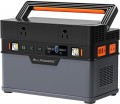Add to comparison |  |  |
|---|---|---|
| Zendure SuperBase 600M | Allpowers S700 | |
| Outdated Product | from $299.00 | |
| User reviews | ||
| TOP sellers | ||
| In box | charging station | charging station |
| Rated power | 600 W | 700 W |
| Peak power | 1000 W | 1400 W |
| Output waveform | sinusoid (PSW) | sinusoid (PSW) |
Outputs | ||
| Sockets (230 V) | 2 | 2 |
| USB A | 3 pcs 5В/2.4А 12 W | 3 pcs 5В/3A 15 W |
| USB C | 1 pcs 5 A 100 W | 1 pcs 5 A 100 W |
| Car cigarette lighter | ||
Inputs (station charging) | ||
| From solar panels | ||
| Via USB-C | ||
| DC input | 2 | |
| Anderson port | 20 H / 5 A | |
Battery and charging time | ||
| Battery type | Li-ion | Li-ion |
| Battery capacity | 607.36 W*h | 606 W*h |
| Charging time (socket) ≈ | 364 min | |
| Charging time (solar panel) ≈ | 364 min | |
| Charging time (socket + USB C PD) ≈ | 227 min | |
| Charging power (socket) | 100 W | |
| Charging power (solar panel) | 160 W | 100 W |
| Charging power (socket + USB C PD) | 160 W | |
General | ||
| Smartphone synchronization | Bluetooth | |
| PSU | external | external |
| Display | ||
| Backlight | ||
| Carrying handle | ||
| Operating temperature | 0 °C ~ +40 °C | |
| Dimensions | 280x190x138 mm | 263x140x180 mm |
| Weight | 6.4 kg | 5.4 kg |
| Added to E-Catalog | february 2023 | january 2023 |
Zendure SuperBase 600M and Allpowers S700 are powerful charging stations, but they have their differences. The SuperBase 600M has a rated power of 600 W and a peak value of 1000 W, while the S700 offers 700 W with a peak of 1400 W, making it a more powerful option. Both devices feature a sine wave output and three USB-A ports, but the S700 offers more charging options, including USB-C and an Anderson port. The S700 charging time is about 364 minutes from an outlet and solar panel, while SuperBase 600M does not specify a particular time but supports solar charging. The SuperBase 600M is heavier (6.4 kg versus 5.4 kg for the S700), which could be an important factor for portability. Both devices have a display and lighting, but the S700 also supports synchronization with a smartphone via Bluetooth. The choice between them depends on your power and functionality needs.